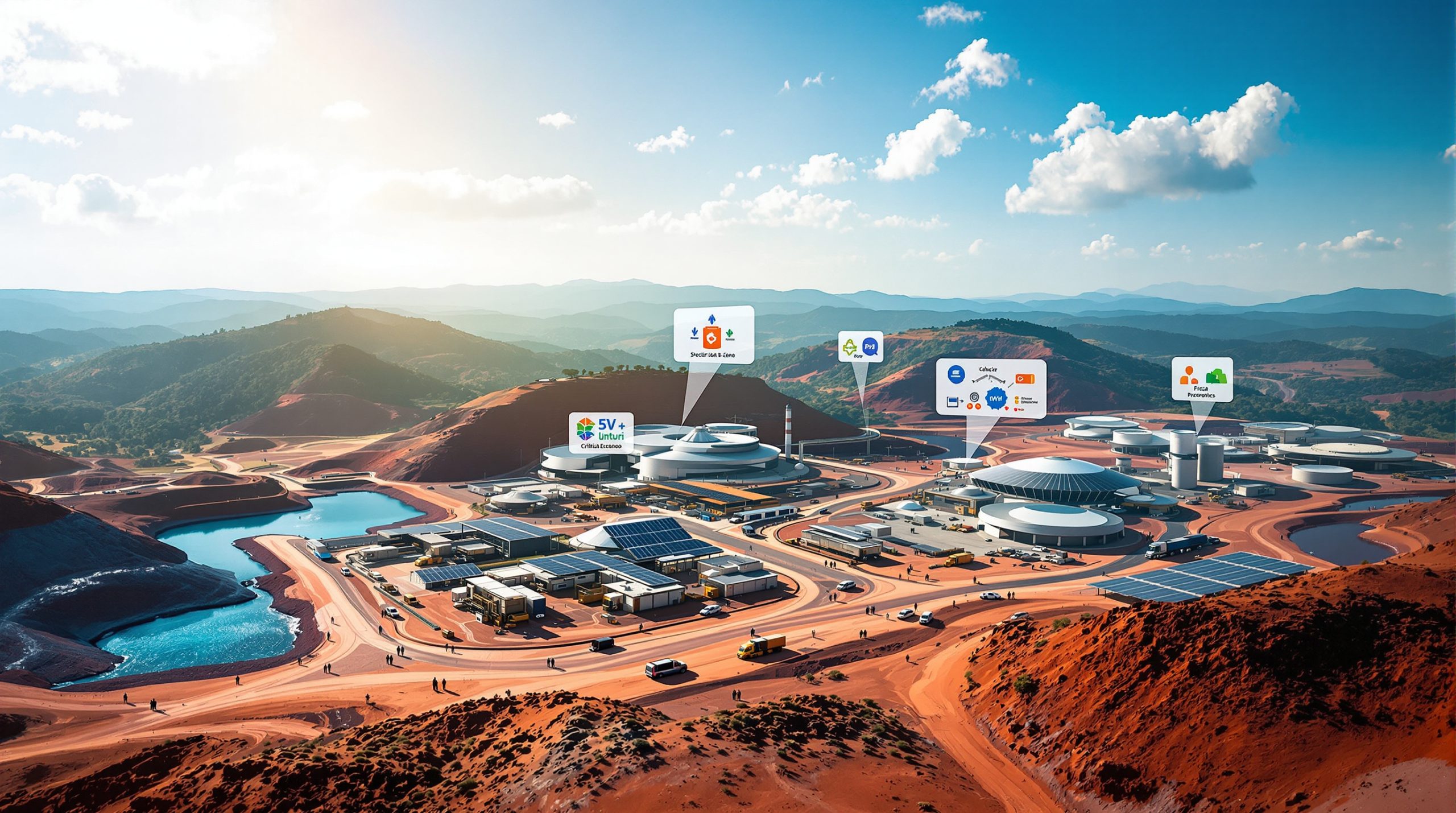What Drove Chile's Copper Production to a Yearly High in May?
Chile's copper production has reached a significant milestone in May 2025, recording the highest monthly output of the year at 486,574 metric tons. This represents a substantial 9.4% year-on-year increase compared to May 2024, marking a decisive turnaround for the country's mining sector after facing several challenging years.
The remarkable rebound comes after Chilean copper production had previously fallen to a 20-year low, primarily due to declining ore grades and operational constraints at major mining facilities. This recovery demonstrates the resilience and adaptability of Chile's copper industry, which remains central to global copper supply forecast.
Record-Breaking Production Figures
The May 2025 production figure of 486,574 metric tons not only represents the highest monthly output for the year but also signals a potential shift in the industry's trajectory. According to data from Chile's National Statistics Institute (INE), this output level exceeds the average monthly production for 2024 by approximately 7.3%.
Mining officials attribute this remarkable recovery to a combination of factors, including:
- Strategic investments in productivity enhancement technologies
- Operational improvements at key extraction sites
- Favorable weather conditions in northern mining regions
- Implementation of advanced ore processing techniques
"After years of struggling with declining ore grades, Chilean mining companies have fundamentally reimagined their extraction and processing methods," notes the Chilean Copper Commission (Cochilco) in its quarterly report. "The May figures represent the first substantive evidence that these strategies are delivering results."
Chile's Position in Global Copper Markets
Chile maintains its status as the world's largest copper producer, accounting for approximately 25% of global copper ore production. This dominant position gives the country significant influence over global supply dynamics and copper price insights.
The importance of Chilean copper to global markets cannot be overstated:
- It supplies critical raw materials for construction, electronics, and renewable energy
- Chilean exports help stabilize global market prices
- The country's production levels serve as a bellwether for global mining trends
- Major manufacturers worldwide depend on Chilean copper for supply chain reliability
The country's copper reserves are estimated at around 200 million metric tons, representing nearly 23% of the world's known copper deposits. This resource endowment underpins Chile's long-term strategic importance in global mineral markets.
How Does This Production Increase Impact the Global Copper Market?
The surge in Chilean production comes at a critical time for global copper markets, which have been experiencing significant supply constraints and inventory challenges throughout early 2025.
Easing of Supply Constraints
The May production increase is already showing signs of alleviating supply pressures in the global market. London Metal Exchange (LME) warehouse data indicates that copper inventories had fallen to multi-year lows of just 85,450 metric tons in April 2025, raising concerns about potential shortages.
"Chile's production recovery couldn't have come at a better time for the market," states commodity analyst Maria Santiago from Global Metal Markets. "We've seen extreme tightness in physical supply throughout Q1, and these additional tons should help restore some balance."
The impact on global supply chains has been notable:
- LME copper inventories increased by 12% in the weeks following the Chilean production announcement
- Spot premiums for physical delivery have decreased by approximately $15-20 per ton
- Price volatility, as measured by the CBOE Copper Volatility Index, declined by 8.3%
- Delivery times for manufacturing sectors have improved by an average of 5.8 days
These improvements represent meaningful relief for copper-intensive industries, particularly electronics manufacturing and construction.
Market Response to Production News
The market reaction to Chile's production figures has been measured but positive. Copper futures on the LME initially dropped 2.1% following the announcement, reflecting the prospect of improved supply. However, prices subsequently stabilized as traders recognized that surging copper demand fundamentals remain strong.
Key market responses include:
- Three-month copper futures settled at $9,850 per metric ton, down from $10,200 before the announcement
- The contango (premium of futures over spot prices) widened to $45 per ton, indicating eased near-term supply concerns
- Trading volumes increased 35% above the 30-day average on the announcement day
- Speculative long positions decreased by 8% according to CFTC data
Institutional investors appear to be recalibrating their medium-term outlook based on improved Chilean supply prospects, though long-term demand growth from electrification and renewable energy remains a bullish factor.
What Challenges Had Been Affecting Chilean Copper Production?
The road to recovery for Chile's copper sector has been arduous, with multiple structural and operational challenges contributing to the previous production decline.
Historical Production Constraints
Prior to the May 2025 rebound, Chilean copper production had fallen to its lowest level in two decades. According to Cochilco data, the average copper ore grade in Chilean mines declined from 1.0% in 2005 to just 0.65% in 2024 – representing a 35% decrease in copper content per ton of processed material.
This decline in ore quality created cascading challenges:
- Higher energy requirements per ton of refined copper
- Increased water consumption for processing lower-grade ores
- Greater waste material generation and management costs
- Reduced processing efficiency and throughput
Another significant constraint has been water scarcity in the Atacama Desert, where many of Chile's largest copper mines are located. The region receives less than 15mm of annual rainfall, forcing mining operations to compete for limited water resources.
"The simultaneous challenges of declining ore grades and water scarcity created a perfect storm for Chilean copper production," explains mining engineer Carlos Vega of the University of Antofagasta. "Addressing either challenge alone would be difficult; tackling both simultaneously required fundamental operational rethinking."
Recovery Strategies Implemented
The May 2025 production figures reflect the success of multiple strategic initiatives implemented by Chilean mining companies:
-
Advanced ore sorting technologies: Implementation of AI-powered X-ray and optical sorting systems that identify and separate higher-grade ore before processing, improving overall grade by 8-12%.
-
Water efficiency innovations: Deployment of dry-stack tailings and advanced water recovery systems that reduce freshwater consumption by up to 45% per ton of processed ore.
-
Operational digitalization: Implementation of integrated mine-to-mill optimization systems that improved overall recovery rates by 5.7% across major operations.
-
Regulatory adaptations: Government policies supporting water rights trading and expedited permitting for productivity investments, reducing project implementation times by 30%.
Codelco copper expansion at El Teniente mine exemplifies these approaches, having invested $1.4 billion in its "Productivity Recovery Program" since 2023. The program has delivered a 14% increase in ore throughput while reducing water consumption by 38% per ton processed.
Which Major Mining Companies Are Driving the Production Increase?
The May 2025 production surge reflects coordinated efforts across Chile's mining sector, though several major players stand out for their contributions.
Key Producer Activities
Codelco, Chile's state-owned mining giant and the world's largest copper producer, contributed approximately 35% of the May production total. The company reported a 12.3% year-on-year increase in its output, reflecting the success of its multi-billion-dollar structural projects program.
Key Codelco initiatives include:
- Completion of the $5.8 billion Chuquicamata Underground transformation
- Ramp-up of the $1.4 billion Rajo Inca expansion at Salvador
- Implementation of the $3.2 billion El Teniente New Mine Level project
- Deployment of autonomous haulage systems at Radomiro Tomic, increasing equipment utilization by 22%
Antofagasta Plc, the UK-listed Chilean mining group, reported a 9.8% year-on-year production increase in May. The company has focused on operational excellence and technological innovation at its flagship Los Pelambres operation.
"Our strategy has been to address ore grade challenges through technology rather than simply accepting declining yields," stated Antofagasta CEO Iván Arriagada in the company's latest earnings call. "The May results validate this approach."
Other significant contributors include BHP's Escondida mine, which increased production by 7.2% through implementation of artificial intelligence-driven predictive maintenance systems that reduced unplanned downtime by 41%.
Production Expansion Projects
Several major expansion projects contributed to the May production surge, with more capacity expected to come online throughout 2025:
| Company | Project | Investment | Capacity Increase | Completion Timeline |
|---|---|---|---|---|
| Codelco | Rajo Inca | $1.4 billion | 90,000 tons/year | Fully operational Q2 2025 |
| Antofagasta | Los Pelambres Expansion | $1.7 billion | 60,000 tons/year | Ramping up through 2025 |
| Teck | Quebrada Blanca Phase 2 | $5.2 billion | 300,000 tons/year | First production Q1 2025 |
| Anglo American | Quellaveco | $5.5 billion | 300,000 tons/year | Full capacity reached Q2 2025 |
These projects collectively represent over $13 billion in capital investment and will add approximately 750,000 tons of annual production capacity – equivalent to nearly 13% of Chile's total 2024 output.
The technological innovations being implemented within these projects are equally significant:
- Autonomous drilling and haulage fleets reducing labor costs by up to 30%
- AI-powered predictive maintenance reducing equipment downtime by 35-45%
- Advanced water recycling systems achieving 85%+ water reuse rates
- Renewable energy integration cutting carbon emissions by 25-40%
What Are the Economic Implications for Chile?
The copper production recovery has substantial implications for Chile's economy, which remains heavily dependent on mining exports.
National Economic Impact
Copper mining contributes between 10-15% of Chile's GDP directly, with additional indirect contributions through supply chains, services, and infrastructure development. According to the Central Bank of Chile, each 1% increase in copper production translates to approximately 0.2% in overall GDP growth.
The May production figures have significant implications:
- Export revenue: The additional production represents approximately $500 million in monthly export value at current New York copper prices
- Tax revenue: Mining royalties and corporate taxes will increase by an estimated $85-100 million monthly
- Employment: An estimated 2,200 direct jobs and 5,500 indirect jobs supported by the production increase
- Investment stimulus: Renewed confidence in the sector has triggered $4.3 billion in new project announcements since the May data release
The Chilean peso strengthened 3.2% against the US dollar following the production announcement, reflecting improved economic prospects and potential foreign exchange inflows.
"The copper sector remains Chile's economic engine," notes economist Elena Rojas of the Universidad de Chile. "The May production figures signal not just a mining recovery but potentially a broader economic turning point."
Regional Development Considerations
The benefits of increased copper production are unevenly distributed across Chile, with mining regions in the north capturing the majority of direct economic impacts.
The Antofagasta region, home to many of Chile's largest mines, expects:
- 1,200 new direct mining jobs by end-2025
- $180 million in additional local procurement spending
- $35 million in community development investments
- Expanded technical training programs benefiting 3,500 residents
However, challenges remain in ensuring sustainable development in mining communities:
- Water competition between mining and agriculture remains intense
- Environmental concerns, particularly dust and tailings management, require ongoing mitigation
- Economic diversification beyond mining continues to be a development priority
- Indigenous communities demand greater consultation and benefit-sharing
Major mining companies have implemented comprehensive social investment programs to address these challenges. Codelco's "Good Neighbor" initiative, for example, allocates 1% of pre-tax profits to community development projects selected through participatory processes.
What's the Outlook for Chilean Copper Production for the Remainder of 2025?
The May production surge appears to be sustainable based on current operational indicators and planned expansions.
Production Forecasts
Cochilco, Chile's copper commission, has revised its 2025 annual production forecast upward to 5.7 million metric tons – representing a 3% increase from 2024 and the first annual growth in three years. This projection includes:
- Q3 2025 forecast: 1.45 million tons (average 483,000 tons monthly)
- Q4 2025 forecast: 1.5 million tons (average 500,000 tons monthly)
- Total H2 2025 forecast: 2.95 million tons
These projections reflect several operational factors:
- Completion of scheduled maintenance at major operations
- Continued ramp-up of new expansion projects
- Seasonal improvement in water availability during Southern Hemisphere winter
- Implementation of additional productivity initiatives currently underway
Historical patterns suggest Q3-Q4 typically show stronger production than Q1-Q2 due to more favorable weather conditions and fewer maintenance shutdowns.
Market Expectations
Analyst consensus generally aligns with the Cochilco forecast, though with some variation in outlook:
- Goldman Sachs projects 5.65 million tons (slightly below Cochilco)
- JP Morgan estimates 5.8 million tons (slightly above Cochilco)
- Macquarie Research forecasts 5.75 million tons
- Chile's Mining Council (Consejo Minero) projects 5.7-5.9 million tons
Key factors that could influence the remainder of 2025 include:
- Labor relations: Collective bargaining at several major mines could impact production if disputes arise
- Equipment availability: Global supply chain constraints for large mining equipment and spare parts
- Water availability: Hydrological conditions in northern Chile remain a critical variable
- Energy costs: Volatility in electricity prices could affect production economics
"While May's production represents a strong recovery signal, sustaining this momentum will require continued operational discipline and favorable external conditions," cautions mining analyst Javier Morales of Santiago Capital. "Labor negotiations at Escondida in September will be a particularly important indicator."
How Does This Development Fit into the Global Copper Supply Landscape?
Chile's copper production recovery has significant implications for global copper markets, particularly as demand continues to grow from electrification and renewable energy.
Comparative Production Analysis
While Chile maintains its position as the world's largest copper producer with approximately 25% of global output, its relative market share has declined from nearly 35% in the early 2000s. Other major producing nations have expanded their output:
| Country | 2024 Production (million tons) | Global Share | 5-Year Growth |
|---|---|---|---|
| Chile | 5.5 | 25% | -2% |
| Peru | 2.8 | 12.7% | +15% |
| DR Congo | 2.2 | 10% | +35% |
| China | 1.9 | 8.6% | +8% |
| United States | 1.3 | 5.9% | +4% |
The May production increase helps Chile maintain its leadership position, though other regions continue to expand their output. Peru, Chile's southern neighbor, has increased production by 15% over five years through projects like Quellaveco and Mina Justa.
Emerging copper regions presenting long-term competition include:
- Indonesia's shift into copper with projects like Grasberg underground
- The Central Asian copper belt (Kazakhstan, Mongolia)
- Serbia's Bor mining district
- Australia's copper-focused exploration boom
Supply Chain Implications
Chile's production recovery has ripple effects throughout global industrial supply chains:
Electronics manufacturing: Major tech companies including Apple, Samsung, and Dell rely on Chilean copper for circuit boards and wiring. The improved supply outlook has reduced procurement risk premiums by an estimated 12%.
Electric vehicle production: Each electric vehicle requires 85kg of copper on average – four times more than conventional vehicles. Tesla and other EV manufacturers have reportedly accelerated production schedules following Chile's improved output.
Renewable energy: Wind and solar facilities use 4-5 times more copper per megawatt than fossil fuel generation. Major developers including NextEra Energy and Iberdrola have cited improved copper availability in their project timelines.
Construction sector: Commercial and residential building, which typically consumes 28% of global copper supply, is experiencing fewer delivery delays and price pressures.
"Chile remains the copper market's central bank," explains materials scientist Dr. Lisa Chen of MIT. "When Chilean copper production stabilizes, the entire downstream supply chain benefits from improved visibility and reduced volatility."
FAQ: Chilean Copper Production
What factors contributed to Chile's previous copper production decline?
Chile's copper production decline stemmed from several interconnected challenges:
- Declining ore grades: Average copper content in Chilean ores fell from 1.0% to 0.65% over two decades, requiring more material processing for the same output.
Looking for the Next Major Mining Opportunity?
Stay ahead of the market with Discovery Alert's proprietary Discovery IQ model, which instantly notifies investors about significant ASX mineral discoveries and turns complex data into actionable insights. Explore how historic discoveries have generated substantial returns by visiting the Discovery Alert discoveries page and start your 30-day free trial today.




